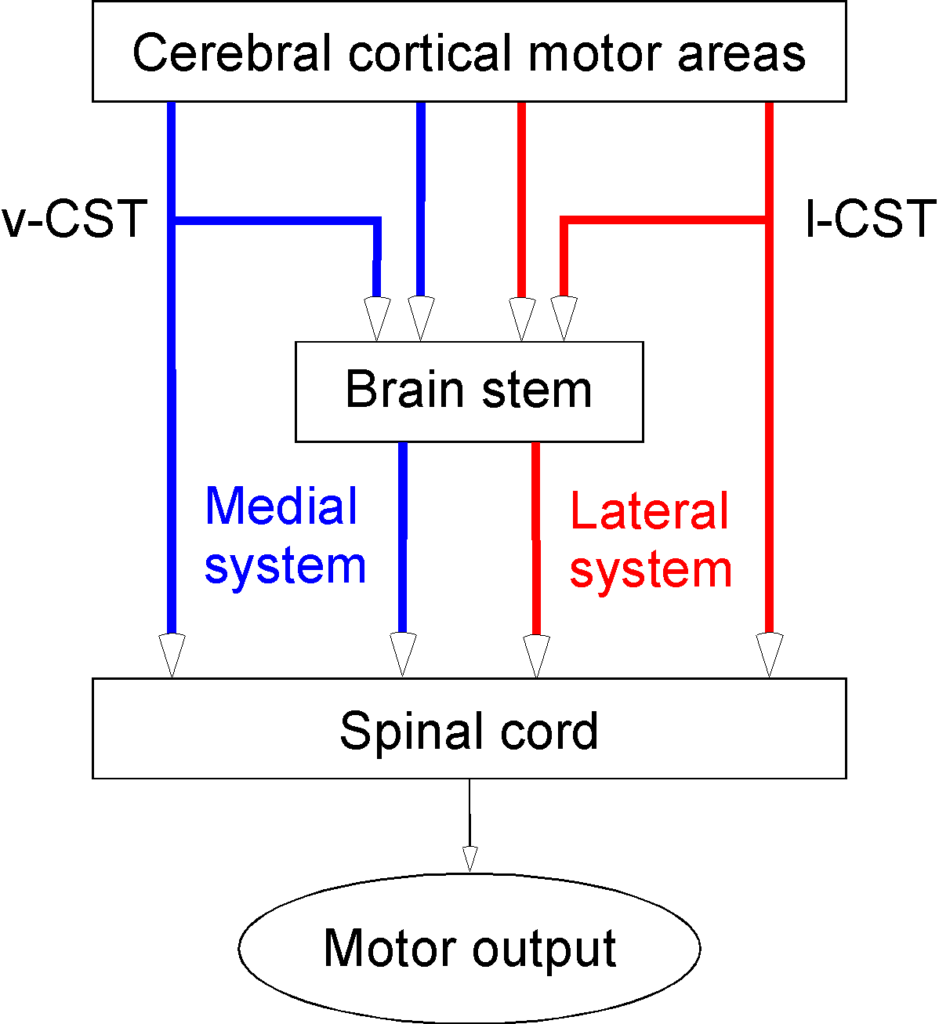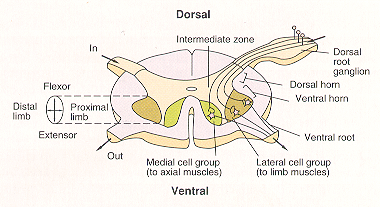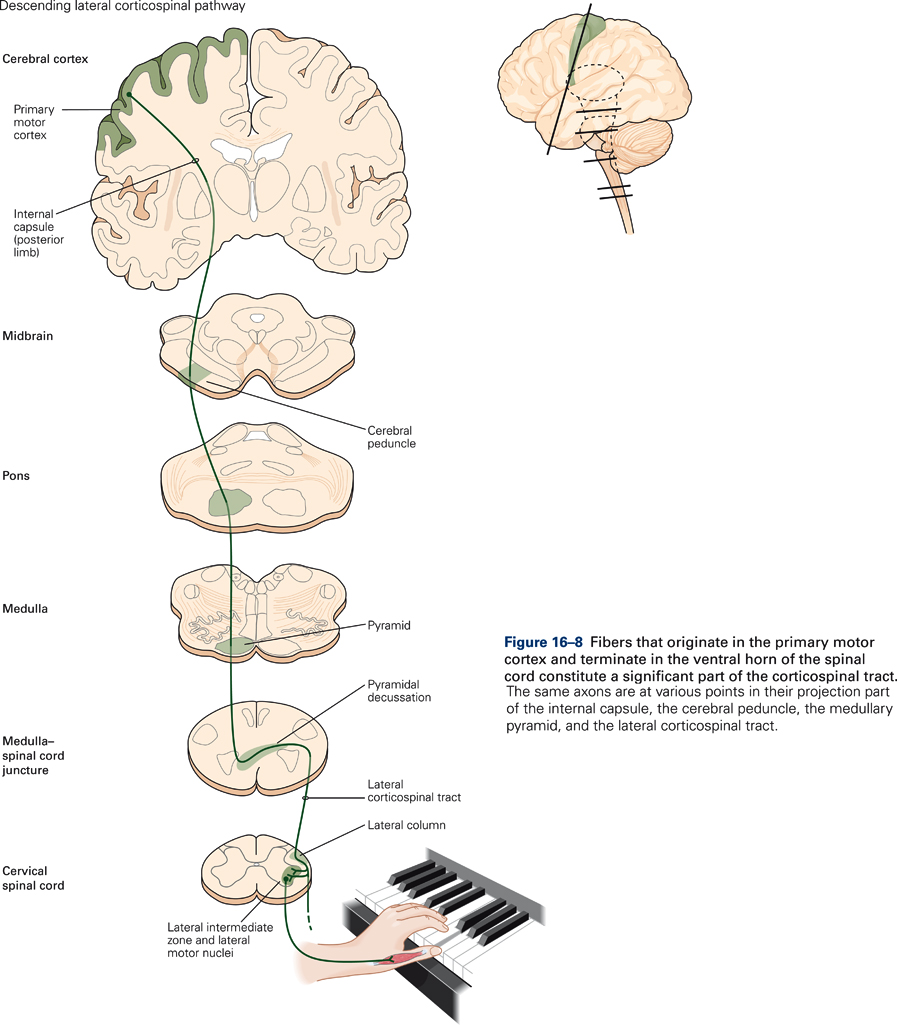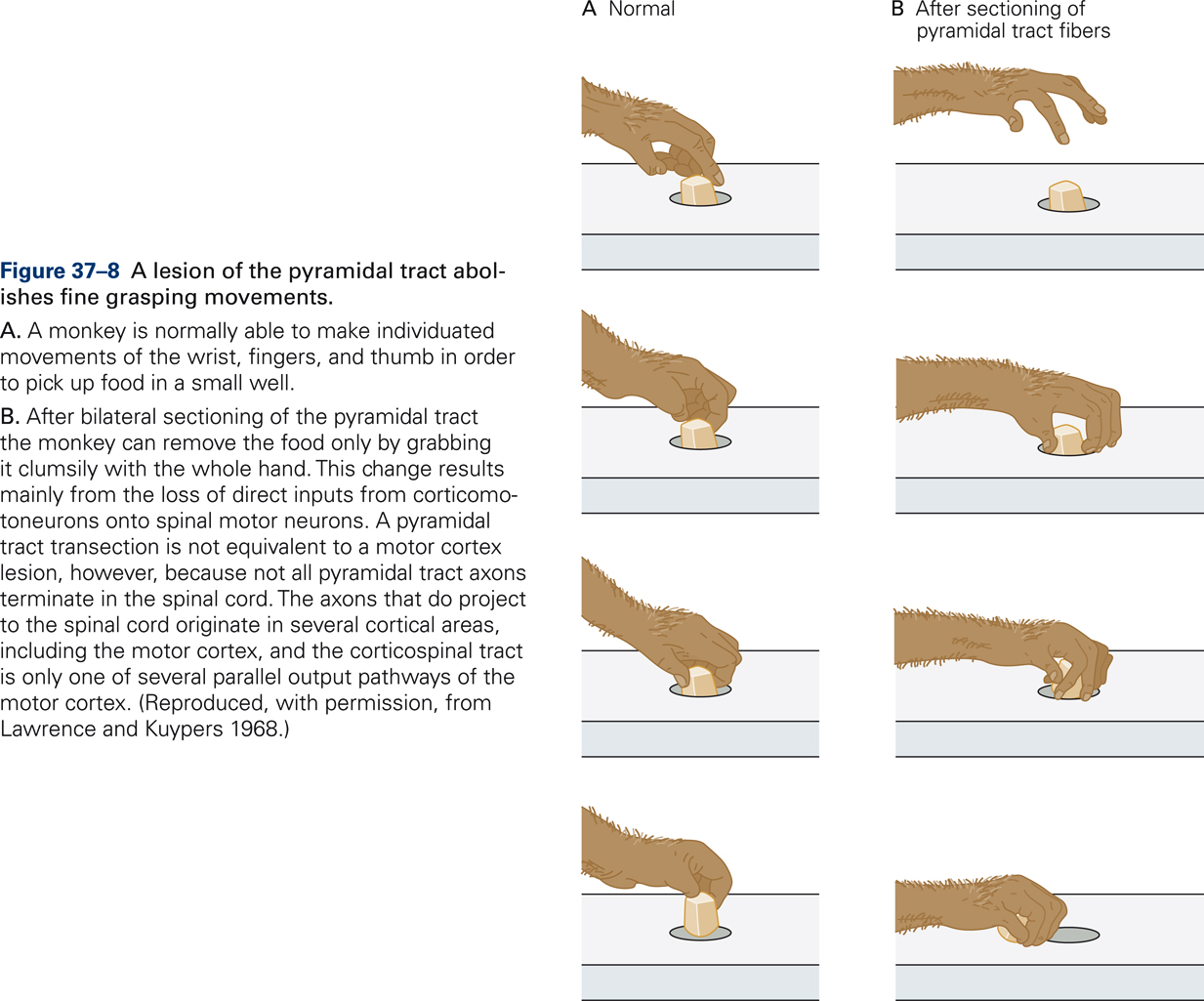M3 | Descending control – Medial system
Descending motor systems – Overview

The spinal cord, brainstem and cerebral cortical motor areas represent three levels of control in the sensorimotor system. These three levels are hierarchically organized, from spinal circuits that control automatic reflexes to brainstem nuclei that control posture and locomotion to motor cortical areas that control voluntary movement. Hierarchical organization simplifies the control of movement by permitting lower levels to generate complex reflexes with minimal intervention of higher levels. Spinal cord, brainstem, and motor cortical areas also function in parallel, so that any one of them can control movement somewhat independently from the other two. How are these three levels of control organized and what are the behavioral deficits that result from damage at the different levels?
Functional organization of the spinal cord
Anatomical relations
Central gray matter (cells bodies) is surrounded by white matter (axons). Motor nuclei in the ventral horn of the spinal cord are organized somatotopically into distinct medial and lateral locations. The medial group innervates axial muscles of the neck and the back. Within the lateral group, the most medial motor neurons innervate proximal muscles; the most lateral innervate distal muscles. Ventral motor neurons innervate extensor muscles; dorsal ones innervate flexors.

Corticospinal (CST) pathways
Corticospinal fibers originate in precentral gyrus area 4 (50%), premotor area 6 (30%) and postcentral areas 3, 2, and 1 (20%). Their axons descend through the internal capsule to the ventral part of the midbrain. The great majority of cortical efferents innervate cells in the pontine nuclei and go no further. Pontine cells are the largest source of mossy fiber input to the cerebellum. The remaining corticospinal fibers continue to the spinal cord through the medullary pyramids and form the pyramidal tract. Most corticospinal fibers cross at the level of the medulla (pyramidal decussation) to form the lateral CST; uncrossed fibers form the ventral CST.

Lateral corticospinal tract
The lateral CST controls movement of the limbs, either directly or via the lateral descending brainstem system. The lateral CST descends in the dorsolateral spinal cord and terminates among interneurons and motoneurons in the dorsolateral part of the ventral horn, which influence distal limb muscles.

Ventral corticospinal tract
The ventral CST controls movement of the trunk and neck, either directly or via the medial brainstem systems. The ventral CST descends in the ventral spinal cord and terminates on interneurons and motoneurons in the ventromedial part of the ventral horn, which influence axial and proximal muscles.
Behavioral deficits following CST lesions
Behavioral deficits resulting from lesions of the corticospinal and descending brainstem pathways have been well studied in monkeys by Hans Kuypers and Don Lawrence in the 1960s. Read the brief review of the lasting impact of these now classic studies (Lemon et al., 2012).

[Lemon, R. N., Landau, W., Tutssel, D., & Lawrence, D. G. (2012). Lawrence and Kuypers (1968a, b) revisited: copies of the original filmed material from their classic papers in Brain. Brain, 135(Pt 7), 2290-2295. Supplementary material]
Key Takeaways
- Lesions of the corticospinal pathways result in contralateral paralysis, progressively recovering to paresis (weakness).
- Voluntary movements recover over several months to an amazing extent, including bipedal posture, limb reaching, and independent operation of the hand.
- Fingers are opened and closed in combination, however, and independent finger movements remain permanently impaired.
Descending brainstem pathways
Multiple parallel pathways are classified into two systems based on their location and termination in the spinal cord: one is the medial system, and the other is the lateral system.

Medial system controls whole-body movements
The medial system descends in the ventral columns of spinal cord and terminates among interneurons and motor neurons in ventromedial spinal gray. The medial system influences motor neurons that innervate axial and proximal muscles. The medial system of brainstem descending pathways includes:
- Vestibulospinal tracts, originate in vestibular nuclei, reflex control of balance and posture.
- Reticulospinal tracts, originate from pontine and medullary reticular formation, maintenance of posture.
- Tectospinal tract, originates in superior colliculus, coordinates head and eye movements
Lateral system controls independent-limb movements
The lateral system descends in the dorsolateral columns of the spinal cord and terminates among interneurons and motor neurons in dorsolateral spinal gray. The lateral system influences motor neurons that innervate distal muscles. The lateral system of brainstem descending pathways includes:
- Rubrospinal tract, originates from magnocellular red nucleus, which controls hand and finger movements during reaching.
Behavioral deficits following lesions
Lesions of descending brainstem pathways result in transient deficits because corticospinal tracts compensate for behavioral deficits. Functions of brainstem pathways have been deduced based on spared (i.e. intact) functions when lesions of the corticospinal tracts are combined with lesions of either the lateral or the medial system of brainstem pathways. Read the brief review of the work of Lawrence and Kuypers (1968) by Lemon et al., 2012.
Lesion of corticospinal tracts combined with lesion of lateral brainstem system (rubrospinal tract):
Lesion of corticospinal tracts combined with lesion of medial brainstem system (reticulospinal tracts):
[Lemon, R. N., Landau, W., Tutssel, D., & Lawrence, D. G. (2012). Lawrence and Kuypers (1968a, b) revisited: copies of the original filmed material from their classic papers in Brain. Brain, 135(Pt 7), 2290-2295. Supplementary material]
Key Takeaways
- Medial system: when the lateral system is lesioned and the medial system is intact, monkeys make well-coordinated, whole body movements (run, jump, and even climb cages), but do not make good use of individual limbs.
- Lateral system: when the medial system is lesioned and the lateral system is intact, monkeys that are supported to prevent falling make good use of individual limbs. They cannot control whole body postures nor can they control individual fingers.
References
- Lemon, R. N., Landau, W., Tutssel, D., & Lawrence, D. G. (2012). Lawrence and Kuypers (1968a, b) revisited: copies of the original filmed material from their classic papers in Brain. Brain, 135(Pt 7), 2290-2295. [PDF]
- Lemon, R. N., Landau, W., Tutssel, D., & Lawrence, D. G. (2012). Lawrence and Kuypers (1968a, b) revisited: copies of the original filmed material from their classic papers in Brain. Brain, 135(Pt 7), 2290-2295. Supplementary material. [PDF]
- Ruhland, J. L., & Van Kan, P. L. E. (2003). Medial pontine hemorrhagic stroke. Physical Therapy, 83, 552-566. [PDF]

